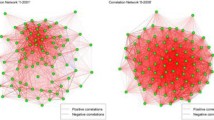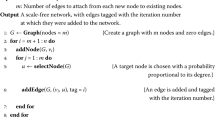Abstract
Given a large social graph, what can we say about its robustness? Broadly speaking, the property of robustness is crucial in real graphs, since it is related to the structural behavior of graphs to retain their connectivity properties after losing a portion of their edges/nodes. Can we estimate a robustness index for a graph quickly? Additionally, if the graph evolves over time, how this property changes? In this work, we are trying to answer the above questions studying the expansion properties of large social graphs. First, we present a measure that characterizes the robustness properties of a graph and also serves as global measure of the community structure (or lack thereof). We show how to compute this measure efficiently by exploiting the special spectral properties of real-world networks. We apply our method on several diverse real networks with millions of nodes, and we observe interesting properties for both static and time-evolving social graphs. As an application example, we show how to spot outliers and anomalies in graphs over time. Finally, we examine how graph generating models that mimic several properties of real-world graphs and behave in terms of robustness dynamics.











Similar content being viewed by others
Notes
This property simply means that the \(\sinh (\cdot )\) function retains the signs of the eigenvalues.
Personal communication with Michael Ley and Florian Reitz from DBLP.
The bipartite graphs do not have odd length closed walks, and thus, the \(\mathrm{SC}\) is computed based on the even length closed walks. This happens replacing the \(\sinh (\cdot )\) function with the \(\cosh (\cdot )\) [15]. But then the \(\mathrm{SC}\) for the bipartite graphs cannot be efficiently approximated using similar ideas with the proposed \(\mathrm{NSC}_k\) (Sect. 4), because of the fact that the \(\cosh (\cdot )\) is an even function. However, our approach for bipartite graphs (Sect. 4, Proposition 4.1) overcomes this bottleneck and can be efficiently computed for large-scale graphs.
References
Akoglu L, McGlohon M, Faloutsos C (2010) OddBall: spotting anomalies in weighted graphs. In: PAKDD, pp 410–421
Albert R, Jeong H, Barabasi A-L (1999) Diameter of the world wide web. Nature 401:130–131
Albert R, Jeong H, Barabasi A-L (2000) Error and attack tolerance of complex networks. Nature 406(6794):378–382
Anagnostopoulos A, Brova G, Terzi E (2011) Peer and authority pressure in information-propagation models. In: PKDD, pp 76–91
Baeza-Yates RA, Ribeiro-Neto B (1999) Modern information retrieval. Addison-Wesley Longman, New York
Barabási A-L, Albert R (1999) Emergence of scaling in random networks. Science 286(5439):509–512
Bollobás B, Riordan O (2003) Robustness and vulnerability of scale-free random graphs. Internet Math 1(1):1–35
Callaway DS, Newman MEJ, Strogatz SH, Watts DJ (2000) Network robustness and fragility: percolation on random graphs. Phys Rev Lett 80(25):5468–5471
Chakrabarti D, Faloutsos C (2012) Graph mining: laws, tools, and case studies. Synthesis lectures on data mining and knowledge discovery. Morgan and Claypool, San Rafael
Chandola V, Banerjee A, Kumar V (2009) Anomaly detection: a survey. ACM Comput Surv 41(3):1–58
Chung FRK (1997) Spectral graph theory. CBMS, regional conference series in mathematics, no. 92. AMS
Cohen R, Havlin S (2010) Complex networks: structure, robustness and function. Cambridge University Press, Cambridge
DBLP Bibliography Server (2006). http://dblp.uni-trier.de/xml/
Erdös P, Renyí A (1960) On the evolution of random graphs. Publ Math Inst Hung Acad Sci 5:17–61
Estrada E, Rodríguez-Velázquez JA (2005) Subgraph centrality in complex networks. Phys Rev E 71(5):056103
Estrada E (2006) Spectral scaling and good expansion properties in complex networks. Europhys Lett 73(4):649–655
Estrada E (2006) Network robustness to targeted attacks. The interplay of expansibility and degree distribution. Eur Phys J B 52:563–574
Faloutsos M, Faloutsos P, Faloutsos C (1999) On power–law relationships of the Internet topology. In: SIGCOMM, pp 251–262
Fortunato S (2010) Community detection in graphs. Phys Rep 486(3–5):75–174
Golub GH, Van Loan CF (1996) Matrix computations, 3rd edn. Johns Hopkins University Press, Baltimore
Hoory S, Linial N, Wigderson A (2006) Expander graphs and their applications. Bull Am Math Soc 43:439–561
KDD Cup (2004). http://www.cs.cornell.edu/projects/kddcup/
Kumar R, Novak J, Tomkins A (2006) Structure and evolution of online social networks. In: KDD, pp 611–617
Lefevre K, Terzi E (2010) GraSS: Graph structure summarization. In: SDM, pp 454–465
Leskovec J, Lang K, Dasgupta A, Mahoney M (2009) Community structure in large networks: natural cluster sizes and the absence of large well-defined clusters. Internet Math 6(1):29–123
Leskovec J, Chakrabarti D, Kleinberg J, Faloutsos C (2010) Kronecker graphs: an approach to modeling networks. J Mach Learn Res 11:985–1042
Leskovec J, Huttenlocher D, Kleinberg J (2010) Predicting positive and negative links in online social networks. In: WWW, pp 641–650
Leskovec J, Kleinberg J, Faloutsos C (2005) Graphs over time: densification laws, shrinking diameters and possible explanations. In: KDD, pp 177–187
Leskovec J, Kleinberg J, Faloutsos C (2007) Graph evolution: densification and shrinking diameters. ACM Trans Knowl Discov Data 1(1):1–41
Maiya AS, Berger-Wolf TY (2010) Expansion and search in networks. In: CIKM, pp 239–248
Malliaros FD, Megalooikonomou V, Faloutsos C (2012) Fast robustness estimation in large social graphs: communities and anomaly detection. In: SDM, pp 942–953
Malliaros FD, Vazirgiannis Michalis (2013) Clustering and community detection in directed networks: a survey. Phys Rep 533(4):95–142
Maserrat H, Pei J (2010) Neighbor query friendly compression of social networks. In: KDD, pp 533–542
Mathioudakis M, Bonchi F, Castillo C, Gionis A, Ukkonen A (2011) Sparsification of influence networks. In: KDD, pp 529–537
McGlohon M, Akoglu L, Faloutsos C (2008) Weighted graphs and disconnected components: patterns and a generator. In: KDD, pp 524–532
Mihail M, Papadimitriou C, Saberi A (2011) On certain connectivity properties of the Internet topology. In: FOCS, pp 28–35
Mislove A, Marcon M, Gummadi KP, Druschel P, Bhattacharjee B (2007) Measurement and analysis of online social networks. In: IMC, pp 29–42
Mohar B (1989) Isoperimetric number of graphs. J Comb Theor B 47(3):274–291
Newman MEJ (2003) The structure and function of complex networks. SIAM Rev 45:167–256
Newman MEJ, Park J (2003) Why social networks are different from other types of networks. Phys Rev E 68:036122
Newman MEJ (2006) Finding community structure in networks using the eigenvector of matrices. Phys Rev E 74(3):036104
Newman MEJ (2006) Modularity and community structure in networks. PNAS 103(23):8577–8582
Page L, Brin S, Motwani R, Winograd T (1999) The PageRank citation ranking: bringing order to the web. Technical Report, Stanford InfoLab
Richardson M, Agrawal R, Domingos P (2003) Trust management for the semantic web. In: ISWC, pp 351–368
Sala A, Cao L, Wilson C, Zablit R, Zheng H, Zhao BY (2010) Measurement-calibrated graph models for social network experiments. In: WWW, pp 861–870
Satuluri V, Parthasarathy S (2009) Scalable graph clustering using stochastic flows: applications to community. discovery. In: KDD, pp 737–746
Seshadhri C, Pinar A, Kolda TG (2013) An in-depth analysis of stochastic Kronecker graphs. JACM 60(2):13:1–13:32
Toivonen H, Zhou F, Hartikainen A, Hinkka A (2011) Compression of weighted graphs. In: KDD, pp 965–973
Tsourakakis CE (2008) Fast counting of triangles in large real networks without counting: algorithms and laws. In: ICDM, pp 608–617
Tsourakakis CE (2011) Counting triangles in real-world networks using projections. Knowl Inf Syst 26:501–520
Viswanath B, Mislove A, Cha M, Gummadi KP (2009) On the evolution of user interaction in Facebook. In: WOSN, pp 37–42
Watts DJ, Strogatz SH (1998) Collective dynamics of ‘small-world’ networks. Nature 393(684):440–442
Acknowledgments
Fragkiskos D. Malliaros is a recipient of the Google Europe Fellowship in Graph Mining, and this research is supported in part by this Google Fellowship. Vasileios Megalooikonomou is partially supported by the ARMOR Project (FP7-ICT-2011-5.1-287720) that is co-funded by the European Commission under the Seventh Framework Programme and by the European Union (European Social Fund—ESF) and Greek national funds through the Operational Program “Education and Lifelong Learning” of the NSRF—Research Funding Program: Thales. Investing in knowledge society through the European Social Fund. Christos Faloutsos is supported by the National Science Foundation under Grants No. IIS-1217559 CNS-1314632, by the Army Research Laboratory under Cooperative Agreement Number W911NF-09-2-0053 and under Contract Number W911NF-11-C-0088, by an IBM Faculty Award and a Google Focused Research Award. Any opinions, findings and conclusions or recommendations expressed in this material are those of the author(s) and do not necessarily reflect the views of the National Science Foundation, or other funding parties. The U.S. Government is authorized to reproduce and distribute reprints for Government purposes notwithstanding any copyright notation here on.
Author information
Authors and Affiliations
Corresponding author
Appendix
Appendix
In this Appendix, we provide a more detailed description of how the property of large spectral gap along with the subgraph centrality measure leads to the measure \(\xi (G)\) [17] as presented in Sect. 3. First of all, the subgraph centrality measure is defined as [15]
where the diagonal entry \(A_{ii}\) of the matrix \(\mathbf {A}^\ell \) contains the number of closed walks of length \(\ell \) that begin and end at the same node \(i\). Focusing on unipartite graphs and keeping only the odd length closed walksFootnote 4 In order to avoid cycles in acyclic graphs, the \(\mathrm{SC}\) can be expressed as
If the graph has good expansion properties (and thus high robustness), it means that \(\lambda _1 \gg \lambda _2\), and then \( u_{i1}^2 \sinh (\lambda _1) \gg \sum _{j=2}^{|V|} u_{ij}^2 \sinh (\lambda _j)\). Thus, Eq. (6) could be written as
This means that for graphs with high robustness, the principal eigenvector \(u_{i1}\) will be related to \(\mathrm{SC}(i)\) as
This relation suggests that if the graph shows high robustness, \(u_{i1}\) will be proportional to \(\mathrm{SC}(i)\) and a log–log plot of \(u_{i1}\) versus \(\mathrm{SC}(i), ~ \forall i \in V\) will show a linear fit with slope \(1/2\) (the discrepancy plot).
Rights and permissions
About this article
Cite this article
Malliaros, F.D., Megalooikonomou, V. & Faloutsos, C. Estimating robustness in large social graphs. Knowl Inf Syst 45, 645–678 (2015). https://doi.org/10.1007/s10115-014-0810-7
Received:
Revised:
Accepted:
Published:
Issue Date:
DOI: https://doi.org/10.1007/s10115-014-0810-7




